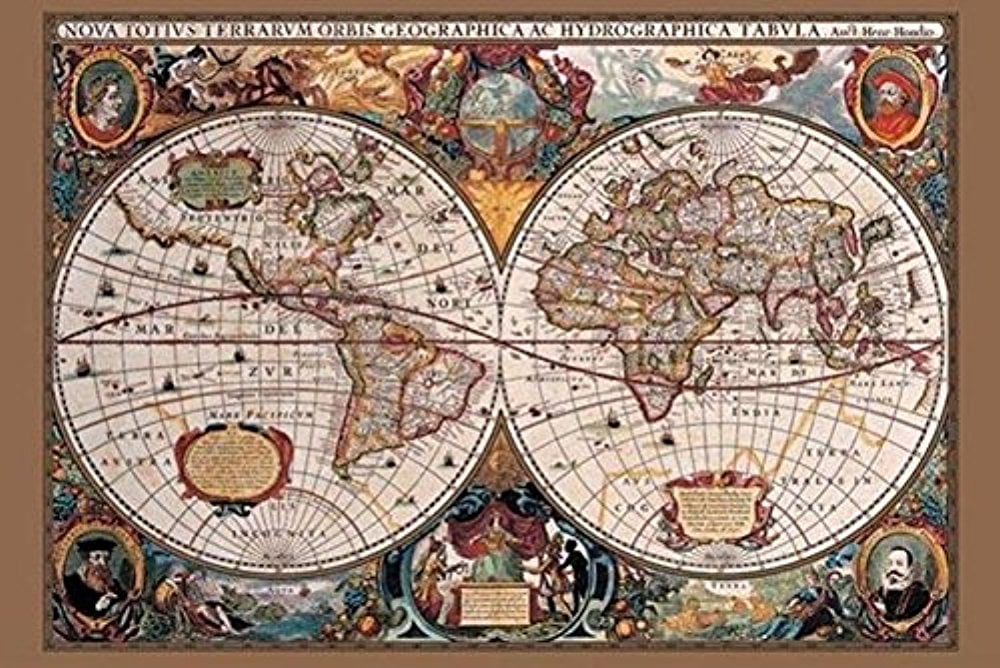

This map is an excellent representation of this history. Even after Kino published a map based on his travels refuting the claim (Paris, 1705), California as an island remained a fixture until the mid-eighteenth century. Father Eusebio Kino initially followed along with this theory but after extensive travels in what is now California, Arizona, and northern Mexico, he concluded that the island was actually a peninsula. Other prominent practitioners like Nicolas Sanson also adopted the new island and the practice became commonplace. The contemporaneous popularity of British cartographer John Speed’s 1626 world map, which included the island of California, may have also influenced Hondius’ decision to deviate from Mercator’s earlier depictions.

Hondius borrowed his outline of California from another widely-distributed map, that of Henry Briggs and printed in Samuel Purchas’ Hakluytus Posthumus or Purchas his Pilgrimes (1625). These included this map’s author, Henricus Hondius, who published the first atlas map to focus solely on North America with the island prominently featured in 1636.

The ideas spread about New Spain and, eventually, most likely via Dutch mariners and perhaps thanks to stolen charts, to the rest of Europe.īy the 1620s, many mapmakers chose to depict the peninsula as an island.

The friar, Fray Antonio de la Ascension, also wrote a Relacion breve of his geographic ideas around 1620. A Carmelite friar who accompanied him later described the land as an island, a description first published in Juan Torquemada’s Monarquia Indiana (1613) with the island details curtailed somewhat. The creation of California as an island was most likely the result of a reading of the travel account of Sebastian Vizcaino, who had been sent north up the shore of California in 1602. Indeed, from its first portrayal on a printed map by Diego Gutiérrez, in 1562, California was shown as part of North America by mapmakers. The inclusion of California as an island here is noteworthy as it breaks from the earlier tradition of Gerardus Mercator and Abraham Ortelius, who correctly depicted Baja California as a peninsula after explorers’ accounts in the mid- to late-sixteenth century disproved early-sixteenth century claims of a sea separating California from the rest of the North American continent. In addition to the numerous beautiful illustrations and map details, several geographic features included on this map are notable, including California as an island, the riverine networks and lakes of North America, and the coastline of Australia.Ĭalifornia is shown here as an island, reflecting a widespread belief among Europeans from the sixteenth to eighteenth centuries. These portraits are not only eye-catching and historically relevant, but also serve to establish Dutch cartography (exemplified by Hondius and Mercator) alongside the Roman cartographic tradition. The map also includes portraits of Gerardus Mercator, Claudius Ptolemy, and Julius Caesar. The mapmaker Henricus Hondius was the son of famed cartographer Joducus Hondius, whose portrait appears at bottom left. Bordered by mythical scenes and fantastic beasts, the world map itself includes charming illustrations of sailing vessels and fish, adding further visual interest to an already engaging tableau. The embellished cartouches and whimsical illustrations make this map an excellent example of baroque-style Dutch cartography. The Hondius examples, however, remain some of the most detailed and decorative. As a result of its popularity, the map served as a base for other cartographers. Four states of this map have been noted between 16. The cartouche at bottom right includes the date 1630, marking this as the first state of the map. It includes unique geographic features and lush detail throughout. Nice old color example of the first state of Henricus Hondius' decorative world map, first issued in the 1630 edition of the Mercator-Hondius Atlas. African Islands, including Madagascar (67)įirst State - One of the Most Famous and Ornately Detailed World Maps of the Seventeenth Century.


 0 kommentar(er)
0 kommentar(er)
